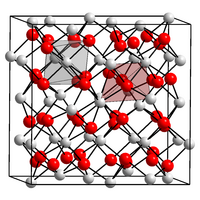Curium (III) oxide
| Crystal structure | ||||||||||
|---|---|---|---|---|---|---|---|---|---|---|

|
||||||||||
| __ Cm 3+ __ O 2− | ||||||||||
| Space group |
Ia 3 (No. 206) |
|||||||||
| Lattice parameters |
a = 1100 pm |
|||||||||
| General | ||||||||||
| Surname | Curium (III) oxide | |||||||||
| other names |
|
|||||||||
| Ratio formula | Cm 2 O 3 | |||||||||
| Brief description |
colorless to slightly brownish solid |
|||||||||
| External identifiers / databases | ||||||||||
|
||||||||||
| properties | ||||||||||
| Molar mass | depending on the isotope: 524–552 g · mol −1 | |||||||||
| Physical state |
firmly |
|||||||||
| Melting point |
2270 ± 25 ° C |
|||||||||
| Hazard and safety information | ||||||||||
 Radioactive |
||||||||||
|
||||||||||
| As far as possible and customary, SI units are used. Unless otherwise noted, the data given apply to standard conditions . | ||||||||||
Curium (III) oxide is a chemical compound of the elements curium and oxygen . It has the empirical formula Cm 2 O 3 . Since all isotopes of curium are only artificially produced, it has no natural occurrence.
presentation
Curium (III) oxide can be obtained by thermal decomposition of curium (IV) oxide in a vacuum (approx. 0.01 Pa ) at 600 ° C:
Another way is given by the reduction of curium (IV) oxide with molecular hydrogen :
properties
It is a colorless to slightly brownish solid that melts at around 2270 ° C. Three modifications of curium (III) oxide are known. The α-form crystallizes in the trigonal crystal system in the space group P 3 m 1 (space group no. 156) and the lattice parameters a = 380 pm and c = 599 pm. The β form of curium (III) oxide has a monoclinic crystal system with the lattice parameters a = 1428 pm, b = 364 pm, c = 888 pm. The γ-curium (III) oxide, which crystallizes in the γ- manganese (III) oxide form, has the lattice parameter a = 1100 pm and the space group Ia 3 (No. 206) .
use
Curium (III) oxide can be used to produce other curium salts. The corresponding salts can be obtained by dissolving the oxide in acids . For example, curium perchlorate can be made by dissolving curium oxide in perchloric acid .
By reacting with anhydrous hydrogen chloride at 400–600 ° C, curium (III) chloride can be obtained.
safety instructions
Classifications according to the CLP regulation are not available because they only include chemical hazard and play a completely subordinate role compared to the hazards based on radioactivity . The latter also only applies if the amount of substance involved is relevant.
literature
- Gregg J. Lumetta, Major C. Thompson, Robert A. Penneman, P. Gary Eller: Curium , in: Lester R. Morss, Norman M. Edelstein, Jean Fuger (Eds.): The Chemistry of the Actinide and Transactinide Elements , Springer, Dordrecht 2006; ISBN 1-4020-3555-1 , pp. 1397-1443 ( doi : 10.1007 / 1-4020-3598-5_9 ).
Individual evidence
- ↑ Gregg J. Lumetta, Major C. Thompson, Robert A. Penneman, P. Gary Eller: Curium , in: Lester R. Morss, Norman M. Edelstein, Jean Fuger (ed.): The Chemistry of the actinides and transactinide element element , Springer, Dordrecht 2006; ISBN 1-4020-3555-1 , pp. 1397-1443 ( doi : 10.1007 / 1-4020-3598-5_9 ).
- ↑ RJM Konings: Thermochemical and Thermophysical Properties of Curium and its Oxides , in: J. Nucl. Mater. , 2001 , 298 (3), pp. 255-268 ( doi : 10.1016 / S0022-3115 (01) 00652-3 ).
- ↑ The hazards emanating from radioactivity do not belong to the properties to be classified according to the GHS labeling. With regard to other hazards, this substance has either not yet been classified or a reliable and citable source has not yet been found.
- ^ LB Asprey, FH Ellinger, S. Fried, WH Zachariasen: Evidence for Quadrivalent Curium: X-Ray Data on Curium Oxides , in: J. Am. Chem. Soc. , 1955 , 77 (6), pp. 1707-1708 ( doi : 10.1021 / ja01611a108 ).
- ^ HO Haug: Curium Sesquioxide Cm 2 O 3 , in: J. Inorg. Nucl. Chem. , 1967 , 29 (11), pp. 2753-2758 ( doi : 10.1016 / 0022-1902 (67) 80014-9 ).
- ↑ M. Noé, J. Fuger, G. Duyckaerts: Some recent Observations on Curium Sesquioxide , in: Inorg. Nucl. Chem. Lett. , 1970 , 6 (1), pp. 111-119 ( doi : 10.1016 / 0020-1650 (70) 80294-X ).
- ↑ JC Wallmann, J. Fuger, JR Peterson, JL Green: Crystal Structure and Lattice parameter of curium trichloride , in: J. Inorg. Nucl. Chem. , 1967 , 29 (11), pp. 2745-2751 ( doi : 10.1016 / 0022-1902 (67) 80013-7 ).


